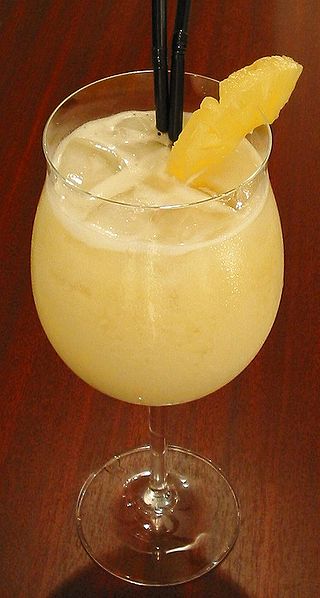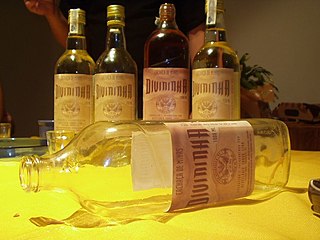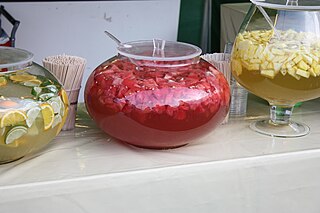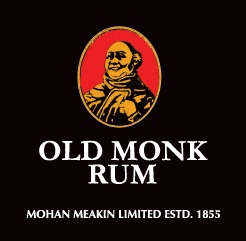Related Research Articles

Rum and Coke, or the Cuba libre, is a highball cocktail consisting of cola, rum, and in many recipes lime juice on ice. Traditionally, the cola ingredient is Coca-Cola ("Coke") and the alcohol is a light rum such as Bacardi; however, the drink may be made with various types of rums and cola brands, and lime juice may or may not be included.

Mojito is a traditional Cuban punch. The cocktail often consists of five ingredients: white rum, sugar, lime juice, soda water, and mint. Its combination of sweetness, citrus, and herbaceous mint flavors is intended to complement the rum, and has made the mojito a popular summer drink.

The piña colada is a cocktail made with rum, cream of coconut or coconut milk, and pineapple juice, usually served either blended or shaken with ice. It may be garnished with either a pineapple wedge, maraschino cherry, or both. The drink originated in Puerto Rico.

Grog is a term used for a variety of alcoholic beverages. The word originally referred to rum diluted with water, which Edward Vernon introduced into the British naval squadron he commanded in the West Indies on 21 August 1740. Vernon wore a coat of grogram cloth and was nicknamed Old Grogram or Old Grog. The Merriam–Webster Collegiate Dictionary, which agrees with this story of the word's origin, states that the word grog was first used in this sense in 1770, though other sources cite 1749. In modern times, the term grog has had a variety of meanings in a number of different cultures, but is commonly used in Australia and New Zealand where it is a slang word for alcohol. In north German culture, Grog is a "classic winter drink from East Frisia" made of rum, sugar and water and heated to boiling point. In Swedish, a "grogg" means a highball drink.

The daiquiri is a cocktail whose main ingredients are rum, citrus juice, and sugar or other sweetener.

Cachaça is a distilled spirit made from fermented sugarcane juice. Also known as pinga, caninha, and other names, it is the most popular spirit among distilled alcoholic beverages in Brazil. Outside Brazil, cachaça is used almost exclusively as an ingredient in tropical drinks, with the caipirinha being the most famous cocktail. In Brazil, caipirinha is often paired with the dish feijoada.

The term punch refers to a wide assortment of drinks, both non-alcoholic and alcoholic, generally containing fruits or fruit juice. The drink was introduced from the Indian subcontinent to England by employees of the East India Company in the late 17th century. Punch is usually served at parties in large, wide bowls, known as punch bowls.

Eggnog, historically also known as a milk punch or an egg milk punch when alcoholic beverages are added, is a rich, chilled, sweetened, dairy-based beverage. It is traditionally made with milk, cream, sugar, egg yolks, and whipped egg whites. A distilled spirit such as brandy, rum, whisky or bourbon is often a key ingredient.
Lamb's Navy Rum is a sugar-cane based Caribbean rum popular in the UK and Canada.

Captain Morgan is a brand of flavored rums produced by British alcohol conglomerate Diageo. It is named after the 17th-century Welsh privateer of the Caribbean, Sir Henry Morgan.

Bumbu is a drink made from rum, water, sugar, and nutmeg. Cinnamon is sometimes substituted for or added to the nutmeg. Modern bumbo is often made with dark rum, citrus juice, grenadine, and nutmeg.

A rum row was a Prohibition-era term (1920–1933) referring to a line of ships loaded with liquor anchored beyond the maritime limit of the United States. These ships taunted the Eighteenth Amendment’s prohibition on the sale and consumption of alcoholic beverages. Although rum prevailed along Caribbean shores, other beverages were popular elsewhere.

Old Monk Rum is an iconic vatted Indian dark rum, launched in 1954. It is a dark rum with a distinct vanilla flavour, with an alcohol content of 42.8%. It is produced in Ghaziabad, Uttar Pradesh and have registered office in Solan, Himachal Pradesh.

A Painkiller is a rum cocktail whose name is trademarked by Pusser's Rum Ltd. It is their signature drink. It is often associated with the British Virgin Islands, its place of origin. The Painkiller is a blend of rum with 4 parts pineapple juice, 1 part cream of coconut and 1 part orange juice, well shaken and served on the rocks with a generous amount of fresh grated nutmeg on top. One serving may be made with two, three, or four ounces of rum.

Rum is a liquor made by fermenting and then distilling sugarcane molasses or sugarcane juice. The distillate, a clear liquid, is often aged in barrels of oak. Rum is produced in nearly every sugar-producing region of the world, such as the Philippines, where Tanduay is the largest producer of rum globally.

A rum swizzle is a rum-based cocktail often called "Bermuda's national drink". The Royal Gazette has referred to it as "the legendary Sam swizzle...perfect for sharing and irresistible to locals and tourists alike". In addition to providing the "swizzle" portion of the 1933 swizzle stick product name, it has been said that this potent cocktail is "as much a part of Bermuda Island culture and cuisine as is the Bermuda onion, the vibrant hibiscus, or the graceful Bermuda Longtail."

Gosling Brothers Limited is a Bermudan company primarily concerned with blending and distributing rum, importing and distributing spirits on the island, and maintaining a retail presence.

The colonial molasses trade occurred throughout the seventeenth, eighteenth and nineteenth centuries in the European colonies in the Americas. Molasses was a major trading product in the Americas, being produced by enslaved Africans on sugar plantations on European colonies. The good was a major import for the British North American colonies, which used molasses to produce rum, especially distilleries in New England. The finished product was then exported to Europe as part of the triangular trade.
References
- ↑ Curtis, Wayne (July 2006). And a bottle of rum - a history of the New World in ten cocktails . Crown Publishers. pp. 285. ISBN 1-4000-5167-3.